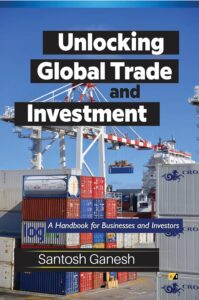
In an era defined by globalization and economic interdependence, the partnership between India and Vietnam has risen as a remarkable beacon of cooperation and shared prosperity. These two nations, each boasting a rich tapestry of history, culture, and economic potential, have converged on a path of collaborative growth and development. The economic cooperation between India and Vietnam stands as a testament to the resilience and dynamism of bilateral relations, offering a compelling model for not only the Indo-Pacific region but also the wider global community.
Soaring Trade and Investment:
Bilateral trade between India and Vietnam has reached impressive heights, surpassing US$14 billion in the fiscal year 2021-22. This achievement represents a remarkable 27% increase year-on-year, underlining the robustness of the economic ties between the two nations. The trade landscape is marked by the diversity of products exchanged, with India exporting pharmaceutical products, agricultural commodities, machinery, and textiles, while Vietnam’s exports include phones and electronic components, coffee, footwear, and machinery.
Investment flows have also been on an upward trajectory. India ranks among Vietnam’s top 10 investors, with investments exceeding US$1.9 billion. These investments span crucial sectors like energy, information technology, and agro-processing. Conversely, Vietnamese investments in India, particularly in pharmaceuticals, IT, and chemicals, are on the rise, further solidifying the economic relationship.
Factors Propelling Growth:
Several key factors have contributed to the significant growth in economic cooperation between India and Vietnam:
- Free Trade Agreements: The India-ASEAN Free Trade Agreement (FTA) and the ASEAN-India Comprehensive Economic Cooperation Agreement (A-ICECA) have played a pivotal role in bolstering trade volumes. These agreements offer preferential tariffs and reduced trade barriers, providing a significant impetus to economic exchanges.
- Geographical Advantage: The maritime link between India and Vietnam facilitates efficient and cost-effective transportation of goods, promoting trade and investment. This geographical proximity is a significant advantage that both nations capitalize on.
- Shared Cultural and Historical Ties: The long-standing cultural and historical bonds between India and Vietnam foster trust and understanding, creating a conducive environment for enhanced cooperation in various sectors.
- Converging Strategic Interests: Both nations share concerns about regional security and stability, aligning their interests in promoting a rules-based order in the Indo-Pacific. This alignment further strengthens their economic and strategic partnership.
Challenges and Opportunities to Navigate:
While India-Vietnam economic cooperation is on a growth trajectory, some challenges must be addressed to unlock its full potential:
- Infrastructure Bottlenecks: Inadequate infrastructure, particularly in logistics and transportation, can hinder seamless trade flow and increase costs. Investment in infrastructure development is crucial for overcoming these bottlenecks.
- Non-Tariff Barriers: Complex customs procedures and regulatory hurdles can impede trade and investment. Streamlining regulations and reducing non-tariff barriers will facilitate smoother economic exchanges.
- Limited Awareness: Businesses in both countries require greater awareness of potential opportunities and market access regulations. Enhanced information sharing and promotion of bilateral trade can bridge this awareness gap.
Future Trajectory: A Symbiotic Partnership in Action:
The future of India-Vietnam economic cooperation holds immense promise and potential. Several developments are poised to further strengthen this symbiotic partnership:
- Digitalization: The adoption of digital technologies and e-commerce platforms will streamline trade processes, enabling businesses to connect seamlessly and expand their reach.
- Emerging Sectors: Collaboration in emerging areas like renewable energy, smart cities, and maritime security offers significant potential for mutual benefit and economic growth.
-
Regional Integration: Deeper engagement with regional initiatives such as the Indo-Pacific Economic Framework for Prosperity (IPEF) can create a broader platform for economic collaboration, ensuring regional prosperity and stability.
The India-Vietnam economic partnership stands as a shining example of the remarkable potential that can be harnessed through collaboration between two dynamic nations. With bilateral trade surpassing US$14 billion and investments steadily on the rise, both countries have demonstrated their unwavering commitment to each other’s economic growth and prosperity.
The partnership’s success can be attributed to various factors, including the pivotal role played by free trade agreements, geographical advantages, shared cultural ties, and converging strategic interests. These elements have not only facilitated trade but have also fostered a sense of trust and camaraderie between India and Vietnam.
While the journey of India-Vietnam economic cooperation has been impressive, it is not without its challenges. Addressing infrastructure bottlenecks, reducing non-tariff barriers, and enhancing awareness among businesses are essential steps in unlocking the full potential of this partnership. These challenges, however, present opportunities for both nations to innovate and collaborate further.
Looking ahead, the future trajectory of this symbiotic partnership appears promising. Embracing digitalization, exploring emerging sectors, and engaging in regional initiatives will undoubtedly pave the way for even deeper economic cooperation. India and Vietnam are poised to embark on a journey towards shared prosperity, sustainable development, and a brighter future together, setting an inspiring example for the Indo-Pacific region and the world at large.

Vietnamese Deputy Prime Minister Tran Luu Quang expressed Vietnam’s interest in fostering cooperation with India, particularly in Gujarat, focusing on areas where India excels and aligning with Vietnam’s priorities. He highlighted the importance of topics discussed at the 10th Vibrant Gujarat Global Summit, including green economy, circular economy, digital economy, e-commerce, and smart cities, all of which are also Vietnam’s development priorities. Quang shared Vietnam’s long-term strategies in these areas and suggested ways to stimulate their development, emphasizing India’s potential as the fifth-largest economy to lead the process. He praised the strong friendship and comprehensive strategic partnership between Vietnam and India, acknowledging India’s support in various fields. Quang also noted that there is ample room for further economic cooperation between the two countries, particularly in emerging sectors such as green economy, circular economy, digital transformation, software, semiconductors, and AI.







